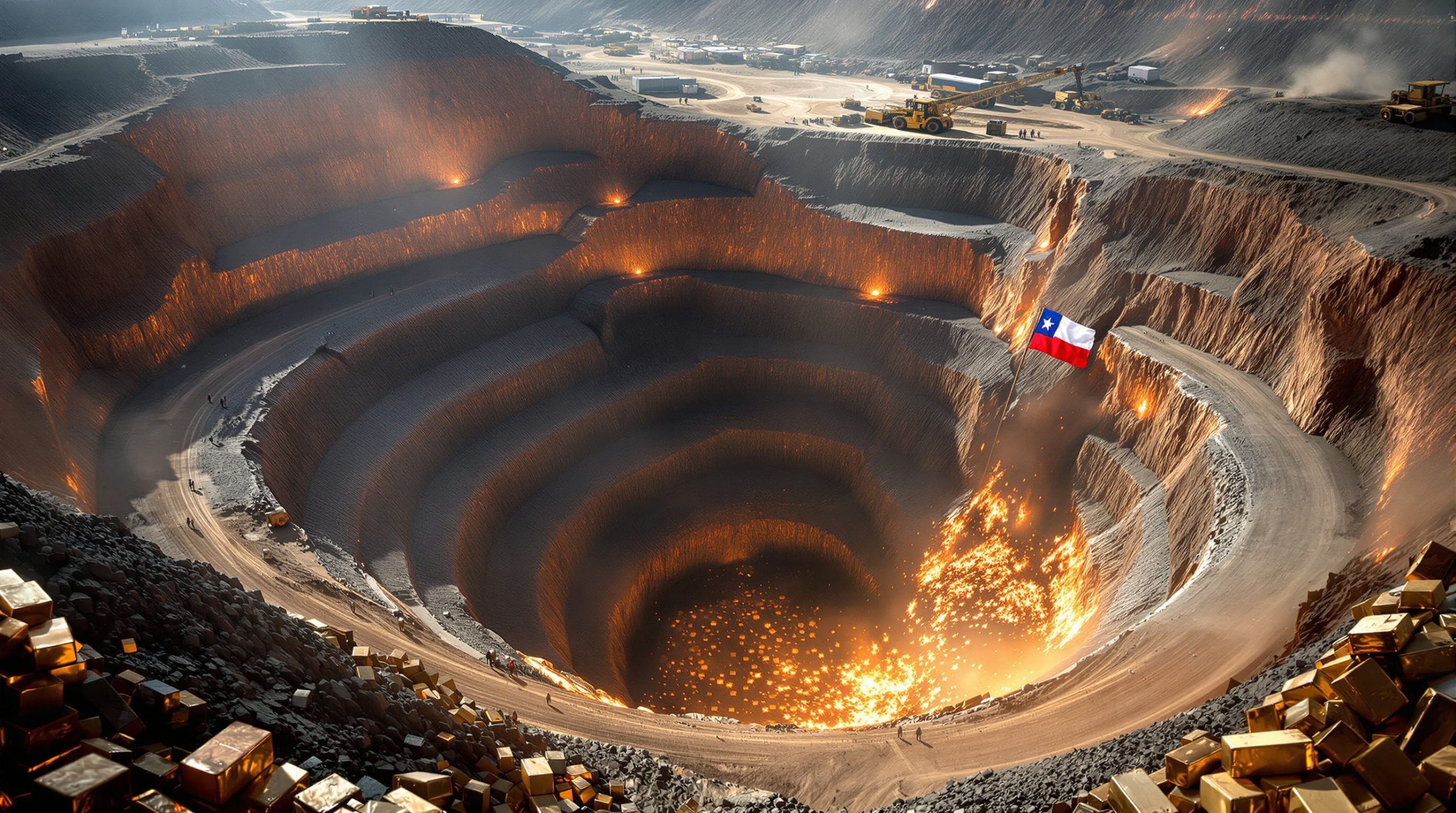What Caused Codelco's Worst Monthly Copper Output in Decades?
The Chilean state-owned mining giant Codelco recorded its lowest monthly copper production in over two decades during August 2025, with output plummeting to just 93,400 metric tons. This represents a dramatic 25% decline compared to the same month in 2024, marking the lowest production level since systematic record-keeping began in 2003, according to data from the Chilean Copper Commission (Cochilco).
The primary catalyst for this historic decline was the catastrophic July 31 tunnel collapse at El Teniente mine, which resulted in six fatalities and nine injuries. This tragedy forced Codelco to suspend operations for more than a week and significantly revise its production forecasts for the remainder of the year.
The accident has created significant ripple effects throughout global copper markets, undermining Codelco's historical position as the world's largest copper producer and adding to growing supply concerns at a critical time for copper demand.
The El Teniente Disaster: Timeline and Impact
-
July 31, 2025: Fatal tunnel collapse occurs at the Andesita section of El Teniente
-
Early August: Complete operational shutdown for safety assessments
-
Mid-August: Partial resumption of activities in unaffected areas
-
August production: 93,400 metric tons (25% below August 2024)
-
Financial impact: Estimated $300+ million in lost revenue based on current market prices
The El Teniente mine disaster represents the Chilean mining industry's worst accident in three decades, with investigations still ongoing regarding potential structural or operational failures that may have contributed to the collapse.
Industry experts note that the disaster couldn't have come at a worse time for Codelco, which was already struggling with structural production challenges even before the accident disrupted operations at one of its flagship mines.
How Does This Decline Affect Global Copper Markets?
The significant production shortfall at Codelco comes at a critical moment for global copper markets, creating substantial supply-side risks just as demand intensifies from multiple sectors. Bloomberg reports indicate that the timing is particularly problematic as the energy transition and data center construction drive increased demand for copper wiring and components.
This production decline is especially concerning given recent research showing over 25% of global copper reserves are currently facing development delays due to environmental, social, and governance challenges across major mining jurisdictions including the US, Peru, Chile, and Panama.
Market Implications of Codelco's Production Crisis
| Factor | Impact |
|---|---|
| Global supply disruption | Reduction of approximately 35,000 tons from annual forecasts |
| Price response | Upward pressure on spot and futures markets |
| Market sentiment | Heightened concerns about supply reliability |
| Competitive positioning | Weakened Codelco market share vs. private miners |
The timing of this production crisis is particularly significant as copper demand accelerates from:
-
Energy transition projects: Renewable power infrastructure requiring extensive copper wiring for transmission networks and generation facilities
-
Data center construction: Rapid expansion driven by AI computing needs, with each facility requiring substantial copper for power distribution and cooling systems
-
Electric vehicle manufacturing: Growing production volumes requiring copper-intensive components including motors, batteries, and charging infrastructure
The supply crunch is reflected in current copper prices, which reached $5.14 per pound in early October 2025, up 1.20% as markets respond to the ongoing production challenges in Chile.
How Does Codelco Compare to Other Major Copper Producers?
The production decline has further eroded Codelco's position relative to other major copper producers, challenging its historical status as the world's largest copper mining company. For the first time in many years, Codelco's monthly production has fallen below that of its main competitor in Chile.
Comparative August 2025 Production Figures
| Producer | August 2025 Output (tons) | Year-on-Year Change |
|---|---|---|
| Codelco | 93,400 | -25% |
| Escondida (BHP) | 105,100 | Minimal change |
| Collahuasi (Anglo American/Glencore) | Slight increase from July | Significant decrease from 2024 |
This production comparison highlights how Codelco's output has now fallen below that of Escondida, BHP's flagship Chilean mine, intensifying questions about the state company's ability to maintain its competitive position in global copper markets.
Cochilco data reveals that while Escondida's production remained relatively stable year-on-year (though down from July 2025), Collahuasi also faces challenges related to ore quality, suggesting broader issues in the Chilean copper sector beyond just Codelco's specific problems.
What Are the Underlying Structural Challenges at Codelco?
While the El Teniente accident represents an immediate crisis, Codelco's production challenges reflect deeper structural problems that have been developing for years. The company had already hit a multi-year production low in 2023, signaling fundamental challenges in its operational model.
Long-Term Production Constraints
-
Aging mine infrastructure: Many facilities operating well beyond original design lifespans, increasing maintenance requirements and safety risks
-
Declining ore grades: Average copper content in extracted material falling steadily, requiring more material to be processed for the same copper output
-
Depth challenges: Mining operations moving increasingly deeper, raising costs and technical complexity while introducing new safety considerations
-
Water scarcity: Operations in water-stressed regions requiring costly desalination solutions and competing with agricultural and community needs
-
Project delays: Consistent timeline extensions for critical expansion projects, complicating production forecasts and capital planning
These structural issues have contributed to a gradual erosion of Codelco's production capacity and competitive position, with the recent accident at El Teniente highlighting the risks associated with aging infrastructure and complex underground mining environments.
How Is Codelco Responding to the Production Crisis?
Facing both immediate operational disruptions and long-term structural challenges, Codelco has implemented a multi-faceted response strategy focusing on both short-term recovery and longer-term structural improvements.
Short-Term Response Measures
-
Safety protocol overhaul: Comprehensive review of underground mining practices with enhanced monitoring and evacuation procedures
-
Production rebalancing: Attempting to increase output at unaffected mines to partially offset El Teniente losses
-
Revised guidance: Lowering annual production forecast from 1.37-1.40 million tons to approximately 1.33-1.36 million tons
-
Operational triage: Prioritizing highest-yield production areas to maximize output from available resources
The company has already resumed operations in areas of El Teniente unaffected by the collapse, but full recovery will take substantial time as safety investigations continue and new protocols are implemented.
Strategic Investment Initiatives
Codelco has authorized substantial capital expenditures exceeding $4 billion in 2025 to address its production challenges through:
-
Mine modernization programs: Converting traditional open-pit operations to underground block-caving to access deeper ore bodies
-
Processing technology upgrades: Implementing more efficient mineral recovery systems to extract more copper from lower-grade ores
-
Structural reinforcement: Enhancing safety in aging underground workings through advanced support systems
-
Expansion projects: Developing new production zones at existing mine sites to replace depleting reserves
The company's leadership has emphasized that these investments are critical not just for maintaining production but for ensuring safer operations with improved environmental performance.
What Does Codelco's Decline Mean for Chile's Economy?
As a state-owned enterprise that has historically generated significant revenue for Chile's government, Codelco's production challenges have broader economic implications for the country's fiscal stability and development plans.
National Economic Impact
-
Reduced fiscal contributions: Lower copper revenues flowing to national treasury, potentially affecting government budgets and social programs
-
Foreign exchange effects: Potential pressure on Chilean peso from reduced mineral exports, affecting import costs and inflation
-
Employment concerns: Questions about workforce stability in mining regions, with potential ripple effects through local economies
-
Investment climate: Signals about Chile's competitiveness in global mining, potentially affecting other mining investments
For decades, Codelco has served as a critical source of government revenue, making its production struggles a national economic concern rather than simply a corporate challenge. The state company's contributions have historically funded education, healthcare, and infrastructure projects across Chile.
How Does This Fit Into Chile's Broader Copper Industry Outlook?
Codelco's struggles reflect wider challenges facing Chile's copper mining industry, which has seen national production stagnate despite significant investment. The country faces increasing competition from other copper-producing nations even as it grapples with internal challenges.
Chilean Copper Sector Challenges
-
Mature mining district: Many operations approaching end-of-life phases requiring substantial reinvestment
-
Permitting complexities: Lengthening timelines for project approvals due to enhanced environmental and community standards
-
Infrastructure limitations: Power and water constraints in key mining regions, necessitating costly solutions
-
Labor relations: Recurring contract negotiations affecting operational continuity across multiple operations
The current crisis at Codelco exemplifies how Chile's copper sector faces a crucial transition period, needing to balance resource depletion, environmental concerns, and community relations while maintaining its position in global markets.
Recent research indicates that Chilean copper reserves are among those facing ESG-related development challenges, potentially limiting the country's ability to expand production despite having significant remaining resources.
What Are the Investment Implications of Codelco's Production Decline?
The production crisis at Codelco creates both challenges and opportunities for various stakeholders in the copper market, from investors to suppliers and competing producers.
Investment Considerations
-
Copper price outlook: Supply constraints supporting higher copper price forecast in both short and medium terms
-
Private producer advantage: Companies like BHP, Anglo American, and Glencore potentially benefiting from Codelco's struggles through improved competitive positioning
-
Supplier opportunities: Mining equipment and service providers focused on productivity enhancement seeing increased demand
-
Project acceleration incentives: Increased urgency for developing new copper sources globally to address potential supply gaps
The situation highlights the growing premium being placed on reliable copper production assets at a time when new project development faces increasing hurdles globally. Investors are increasingly distinguishing between copper producers based on operational stability, jurisdictional risk, and production cost profiles.
The current copper price of $5.14 per pound reflects these supply concerns, creating favorable economics for producers able to maintain stable operations during this period of market tightness.
What Are the Prospects for Codelco's Production Recovery?
Despite the current crisis, Codelco has outlined recovery pathways that could potentially restore production levels over the medium term, though industry analysts remain cautious about the company's ability to execute these plans.
Recovery Timeline Projections
| Project | Expected Impact | Timeline |
|---|---|---|
| El Teniente New Level | +50,000 tons annually | Partial operations by Q2 2026 |
| Chuquicamata Underground | Stabilize production | Full transition by end-2026 |
| Rajo Inca (Salvador) | +90,000 tons annually | Ramping up through 2026 |
| Andina Future Development | Maintain current levels | Design phase, implementation 2027+ |
These projects represent Codelco's attempt to counter the natural decline in its aging mines through a combination of mine life extensions, underground conversions, and processing improvements. However, the company faces significant execution challenges given its historical pattern of project delays.
Industry experts note that while these projects could theoretically restore Codelco's production capacity, the company faces mounting technical challenges as it pursues increasingly complex mining operations at greater depths and with lower grades.
FAQ: Understanding Codelco's Copper Production Challenges
Why is Codelco's production decline significant for global markets?
Codelco has historically been one of the world's largest copper producers, accounting for a substantial percentage of global output. Any significant disruption to its production creates ripple effects through global supply chains, particularly as copper demand accelerates for energy transition applications. The timing is especially problematic given the limited ability of other producers to quickly increase output to compensate.
How do Codelco's production challenges compare to private mining companies?
While Codelco has struggled with declining production, some private operators like BHP have maintained more stable output at their Chilean operations. This divergence reflects differences in investment approaches, operational practices, and the particular challenges of Codelco's aging asset base. Private companies have generally been able to deploy capital more efficiently for mine modernization and expansion.
What role does copper grade play in Codelco's production challenges?
Declining ore grades have been a persistent challenge for Codelco, with the average copper content in processed material falling steadily. This requires processing more rock to extract the same amount of copper, increasing costs and environmental impacts while reducing output efficiency. Similar challenges are affecting other Chilean producers like Collahuasi, which has reported issues with "lower quality ore" in recent periods.
How might Codelco's production issues affect copper prices?
Supply disruptions of this magnitude typically create upward pressure on copper prices, particularly in a market already concerned about medium-term supply adequacy. However, the price impact may be moderated by macroeconomic factors and demand uncertainty in key markets. The current price of $5.14 per pound reflects some of this supply concern but is also influenced by broader economic conditions.
What are the environmental implications of Codelco's production challenges?
The need to process more material to compensate for declining grades increases the environmental footprint per ton of copper produced. This creates additional challenges as Codelco simultaneously works to reduce its carbon intensity and water consumption in line with sustainability targets. The company must balance production recovery with increasing environmental standards and community expectations.
Further Exploration:
Readers interested in learning more about challenges in global copper production outlook can explore related educational content on MINING.com, Bloomberg, and other industry publications that regularly cover developments in the copper sector. For specific information on mineral exploration for copper and copper investment strategies, the company's official communications and Chilean government mining data provide additional context.
Want to Spot the Next Major Copper Discovery Before the Market?
Discovery Alert's proprietary Discovery IQ model delivers real-time alerts on significant ASX mineral discoveries, instantly transforming complex copper and resource data into actionable investment insights. Explore why major mineral discoveries can lead to substantial returns by visiting Discovery Alert's dedicated discoveries page and position yourself ahead of the market.




